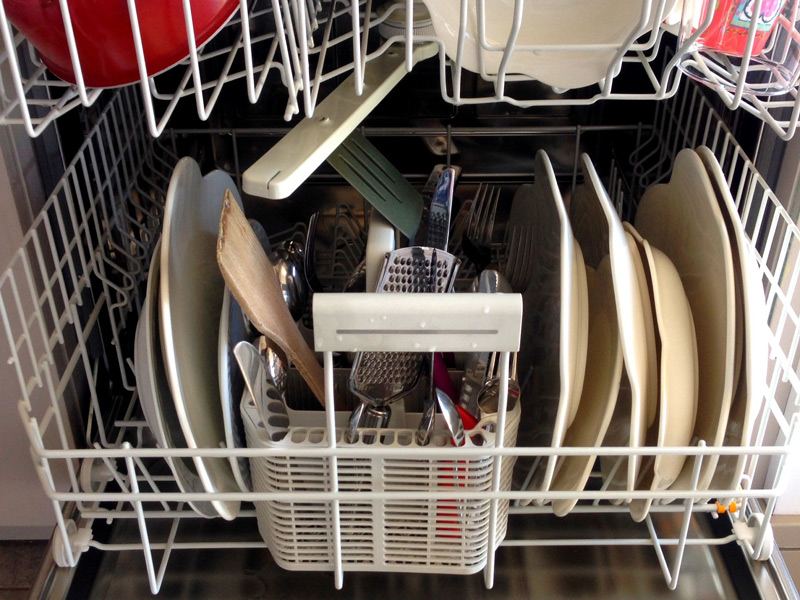Your dishes won't be clean if your dishwasher isn't.
Your dishwasher should, theoretically, be cleaning itself all the time, but unfortunately, it doesn't.
Food particles, grease, detergent that hasn't been fully dissolved, and water minerals accumulate over time in the dishwasher's filter and walls. This muck can actually leave stains and film on your glasses, plates, and flatware in addition to having an unpleasant smell. That basically implies that no matter how carefully you fill your dishwasher, it won't be able to complete its job correctly.
Additionally, if you let the food and filth accumulate, it may harm the dishwasher's filter and pump, requiring expensive repairs.

If your dishwasher isn't draining, it's likely that the filter is clogged.
Even if it isn't, cleaning the filter is a vital (although unpleasant) element of your dishwasher routine since grease and food scraps can accumulate in it, causing clogs, foul odours, and other hygiene issues. Keeping your filter clean also helps your dishwasher run more effectively and reduces the likelihood of food scraps getting further inside the machine.
Modern dishwashers are designed to make filter removal and cleaning simple, so there's no reason to put it off any longer.
Step 1. Empty the dishwasher and remove the lower basket. The filter is located in the sump or bottom of the dishwasher and can be twisted off without tools (but you can always refer to the manual if it gets stuck).
Step 2. Rinse the internal filter under running water and gently scrub it with a plastic brush to remove oil and dirt. Large trap filters can be easily rinsed with hot water.
Step 3. Reverse the removal process to re-install the filter.
In addition to being disgusting, a mouldy or dirty dishwasher can be quite detrimental to your health.
No home can ever be totally mould-free due to the airborne mould spores, and the warm, wet environment inside your dishwasher is the perfect place for mould to thrive. Additionally, if your dishwasher has any trace of dirt or grime, it can serve as a breeding ground for bacteria that could contaminate all of your clean dishes.
While there are obvious signs of mould, such as visible black spots or a musty smell coming from your dishwasher, it's possible mould could be growing without your knowledge, It's best to assume that there is mould in your dishwasher even if you can't see it because many varieties of mould are small, colourless, and odourless.
To deep clean your dishwasher just follow these steps:
Step 1: Begin by removing the racks and cleaning them in hot, soapy water.
Step 2: Wipe clean the inside of the dishwasher and around the door seal with a soapy sponge.
Step 3: Replace the racks and let everything air dry completely.
Step 4: The mould and bacteria will then be killed using white vinegar. Fill a dishwasher-safe container halfway with vinegar and place it on the top rack with the lid off. Use between 1 - 2 cups of vinegar.
Step 5: Start a hot water cycle with the dishwasher empty except for the container with the vinegar.
Step 6: Sprinkle a cup of baking soda in the dishwasher and run it for a second hot cycle.
If the previous method didn't work to remove that bad smell you may have a more serious problem, but there are some further steps you can take to remove that bad odour.
Step 1: Remove the racks and give them another good clean.
Step 2: Clean the filter. There is no part of your dishwasher that is more likely to be the source of bad odours than the filter, where grease and food particles can accumulate quickly. See our comprehensive directions for filters at the beginning of this article.
Step 3: Sprinkle a cup of baking soda in the tub's bottom and leave it there overnight (baking soda is famous for absorbing nasty odours). The following morning, run a hot cycle to see if the baking soda has eliminated any odours.
For this final step, we'd recommend getting a qualified plumber to take care of it.
Step 4: Check the drain hose for obstructions, because these can prevent dirty water from draining properly and result in a smelly pool of water. If there is water collecting in the bottom of your dishwasher, the drain line may require some maintenance. For access, you might need to take your dishwasher out of the cabinets and unplug the drain hose from the sink's undermount drain.
If you have any specific concerns in regards to your dishwasher or are looking for a dishwasher installation service, Give the friendly team a Jetset Plumbing a call on 1800 443 996.

